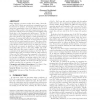Free Online Productivity Tools
i2Speak
i2Symbol
i2OCR
iTex2Img
iWeb2Print
iWeb2Shot
i2Type
iPdf2Split
iPdf2Merge
i2Bopomofo
i2Arabic
i2Style
i2Image
i2PDF
iLatex2Rtf
Sci2ools
CODES
2006
IEEE
2006
IEEE
A buffer-sizing algorithm for networks on chip using TDMA and credit-based end-to-end flow control
When designing a System-on-Chip (SoC) using a Networkon-Chip (NoC), silicon area and power consumption are two key elements to optimize. A dominant part of the NoC area and power consumption is due to the buffers in the Network Interfaces (NIs) needed to decouple computation from communication. Having such a decoupling prevents stalling of IP blocks due to the communication interconnect. The size of these buffers is especially important in real-time systems, as there they should be big enough to obtain predictable performance. To ensure that buffers do not overflow, end-to-end flow-control is needed. One form of end-to-end flow-control used in NoCs is credit-based flow-control. This form of flowcontrol places additional requirements on the buffer sizes, because the flow-control delays need to be taken into account. In this work, we present an algorithm to find the minimal decoupling buffer sizes for a NoC using TDMA and creditbased end-to-end flow-control, subject to the ...
| Added | 10 Jun 2010 |
| Updated | 10 Jun 2010 |
| Type | Conference |
| Year | 2006 |
| Where | CODES |
| Authors | Martijn Coenen, Srinivasan Murali, Andrei Radulescu, Kees Goossens, Giovanni De Micheli |
Comments (0)

